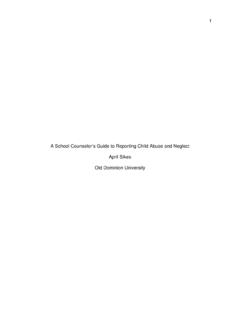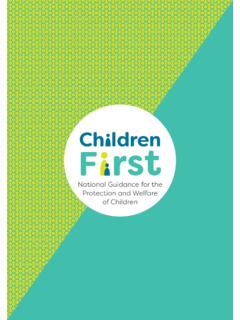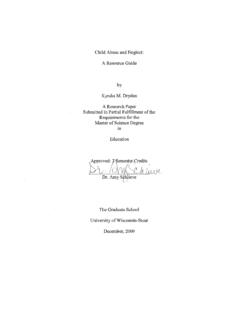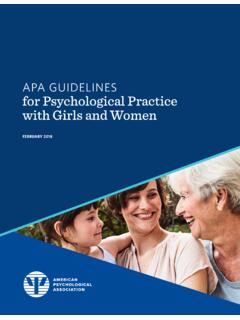Transcription of Preventing Child Sexual Abuse
1 Does not fully comprehend,does not consent to, oris unable to give informed consent to, oris not developmentally prepared for and cannot give consent to1 WHAT IS Child Sexual Abuse ? Child Sexual Abuse is the involvement of a Child (person less than 18 years old) in Sexual activity that violates the laws or social taboos of society and that he/she National Center for Injury Prevention and Control Division of Violence PreventionWHAT ARE THE IMPACTS?Many children wait to report or never report Child Sexual Abuse . Experiencing Child Sexual Abuse is an adverse childhood experience (ACE) that can affect how a person thinks, acts, and feels over a lifetime, resulting in short- and long-term physical and mental/emotional health consequences.
2 Examples of physical health consequences include: Examples of mental health consequences include:Examples of behavioral consequences include:unwanted/unplanned pregnancies2 physical injuries3 long-term chronic conditions such as heart disease, obesity, and cancer4depression5post-traumatic stress disorder substance abuserisky Sexual behaviors6suicide or suicide attempts7 Preventing CHILDSEXUAL Abuse CURRENT GAPS IN Child Sexual Abuse PREVENTIONA dults must take the steps needed to prevent Child Sexual Abuse . Adults are responsible for ensuring that all children have safe, stable, nurturing relationships and environments. Resources for Child Sexual Abuse have mostly focused on treatment for victims and criminal justice-oriented approaches for perpetrators.
3 While these efforts are important after Child Sexual Abuse has occurred, little investment has been made in primary prevention, or Preventing Child Sexual Abuse BEFORE it occurs. Thus, limited effective evidence-based strategies for proactively protecting children from Child Sexual Abuse are available. More resources are needed to develop, evaluate, and implement evidence-based Child Sexual Abuse primary prevention strategies to ensure that all children have safe, stable, nurturing relationships and environments. 1 IN 4 GIRLS AND 1 IN 13 BOYS experience Child Sexual Abuse at some point in MILLION children experience Sexual Abuse each year in the United States11.$ BILLIONThe total lifetime economic burden of Child Sexual Abuse in the United States in 2015 (although this is likely an underestimate of the true impact of the problem since Child Sexual Abuse is underreported)9 APPROXIMATELY 90%of Child Sexual Abuse is perpetrated by someone the Child or Child s family knows10.
4 MillionDevelop research that assesses exposure to Child Sexual Abuse and risk and protective factors over time to inform primary prevention effortsIdentify risk and protective factors for Child Sexual Abuse at multiple levels of influence individual, relationship, community, and societal Examine and identify distinctions between different types of Child Sexual Abuse perpetration to inform primary prevention effortsDetermine how risk and protective factors for Child Sexual Abuse perpetration interact with other forms of violence perpetration to better prevent all forms of violenceAct on the best available evidence now scale-up, implement, and communicate information about existing evidence-based strategies to prevent Child Sexual abuseExplore how to adapt the existing evidence-based interventions for different populations and settings Identify strategies for effectively communicating best practices for Child Sexual Abuse prevention among practitioners, researchers.
5 Clinicians and others working directly with childrenDevelop and implement surveillance systems to assess Child Sexual Abuse perpetration and victimization in real-time to measure recent and lifetime exposureUse standard definitions and measures of Child Sexual Abuse to increase availability and quality of dataCollect data focused on victimization AND perpetration of all forms of Child Sexual Abuse to improve our understanding of all aspects of Child Sexual Abuse Further evaluate evidence-based approaches in different populations, communities, and settingsIdentify, develop and evaluate programs and practices that reduce youth and adult perpetrated CSA Develop and evaluate comprehensive primary prevention programs, practices, and policies that address individual, relationship, community, and societal factors that impact Child Sexual abuseCDC surveillance systems, violence prevention initiatives, and efforts to support partners in the field have increased our understanding of Child Sexual Abuse , but critical gaps still need to be addressed.
6 We can all lead efforts to prevent Child Sexual Abuse and improve the health, well-being, and quality of life for children, families, and communities. CDC has identified gaps in research and practice that are important to address in our efforts to promote primary prevention of Child Sexual Abuse . RECOMMENDATIONS FOR FUTURE RESEARCH ON Child Sexual ABUSEI ncrease understanding of risk and protective factors Disseminate and implement evidence-based policies, programs, and practicesImprove surveillance systems and data collectionStrengthen and develop evidence-based policies, programs, and practices Youth and family-serving organizations, public/governmental agencies, faith communities, and others must have the information necessary for effective primary prevention strategies.
7 Child Sexual Abuse is preventable, and CDC provides leadership, using a public health approach, to reduce children s exposure to Sexual Abuse and ensure safe, stable, nurturing relationships and environments for all TO LEARN MORE PLEASE VISIT: Health Organization. (2003). Guidelines for medico-legal care for victims of Sexual violence. Geneva, Switzerland: , R. T., Lewis, T., & Zolotor, A. J. (2011). A review of physical and mental health consequences of Child Abuse and neglect and implications for practice. American Journal of Lifestyle Medicine, 5, 454 , R. T., Lewis, T., & Zolotor, A. J. (2011). A review of physical and mental health consequences of Child Abuse and neglect and implications for practice. American Journal of Lifestyle Medicine, 5, 454 , V.
8 J., Anda, R. F., Nordenberg, D., .. & Marks, J. S. (1998). Relationship of childhood Abuse and household dysfunction to many of the leading causes of death in adults: The Adverse Childhood Experiences (ACE) study. American Journal of Lifestyle Medicine, 14, , F. W. (2003). Ten-year research update review: Child Sexual Abuse . Journal of the American Academy of Child & Adolescent Psychiatry, 42, , V. J., Anda, R. F., Nordenberg, D., .. & Marks, J. S. (1998). Relationship of childhood Abuse and household dysfunction to many of the leading causes of death in adults: The Adverse Childhood Experiences (ACE) study. American Journal of Lifestyle Medicine, 14, , P. E., Cooper, C., Minot, S., Brugha, T. S., Jenkins, R., Meltzer, H., & Dennis, M.
9 (2009). Suicide attempts, gender, and Sexual Abuse : Data from the 2000 British Psychiatric Morbidity Survey. American Journal of Psychiatry, 166, , N., Guilera, G., Forns, M., & G mez-Benito, J. (2009). The prevalence of Child Sexual Abuse in community and student samples: A meta-analysis. Clinical Psychology Review, 29, 328 338. , E. J., Brown, D. S., Fang, X., Hassan, A., & Mercy, J. A. (2018). The economic burden of Child Sexual Abuse in the United States. Child Abuse & Neglect, 79, , D., & Shattuck, A. (2012). Characteristics of crimes against juveniles. Durham, NH: Crimes Against Children Research Center. Retrieved from , D., Turner, H. A., Shattuck, A., & Hamby, S. L. (2015). Prevalence of Child exposure to violence, crime, and Abuse : Results from the National Survey of Children s Exposure to Violence.
10 JAMA Pediatrics, 169(8), 746-754. doi.

















